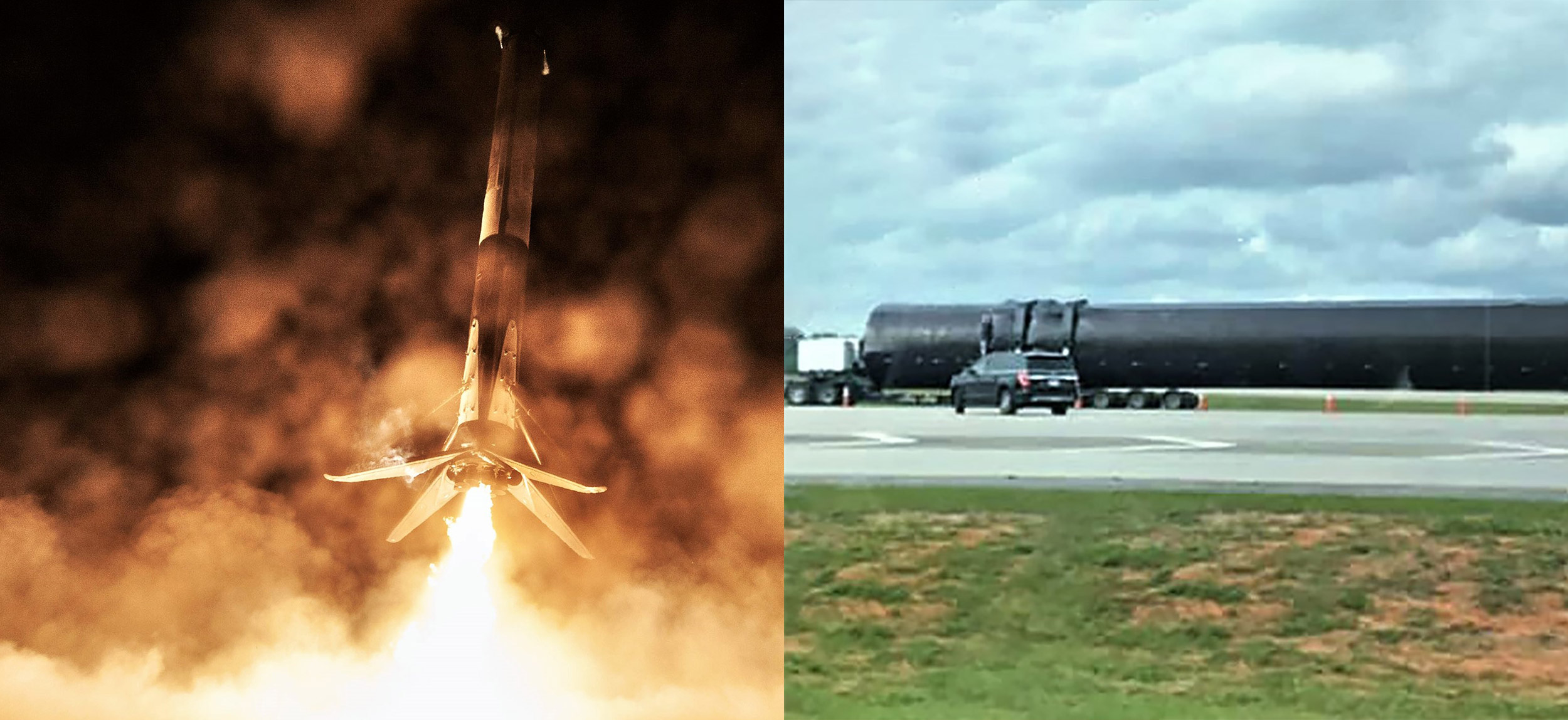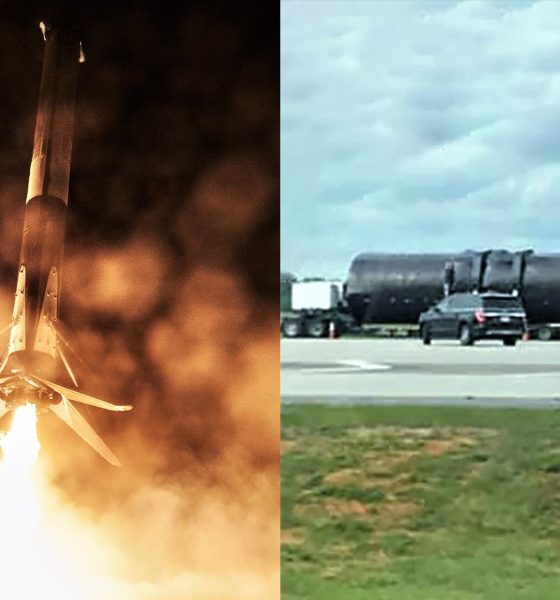

News
SpaceX ships Falcon 9 booster west for second California launch of 2019
A local resident spotted a SpaceX Falcon 9 booster heading west out of Florida, likely bound for the company’s SLC-4E Vandenberg Air Force Base (VAFB) launch pad and second California launch of 2019.
Barring a surprise reassignment, the booster Joshuah Murrah caught is Falcon 9 B1051, on its way west some 50 days after successfully supporting Crew Dragon’s March 2nd launch debut. Despite the availability of B1046, B1047, and B1049, B1051 was assigned to the Canadian Space Agency’s (CSA) Radarsat Constellation Mission (RCM) shortly after landing aboard OCISLY, triggering major launch delays. The most logical explanation for customer CSA’s and satellite contractor Maxar Technologies’ curious decision is that they must believe that Falcon 9 Block 5 boosters with more than one launch in their past add more risk than those that do not.
According to an April 16th update from CSA, RCM’s launch was scheduled for no earlier than (NET) late May or early June, although word on the ground is that mid-to-late June is now a more likely target. Contrary to rumors of delays, B1051’s shipment west indicates that SpaceX has more or less completed the booster’s refurbishment, likely the easiest Falcon 9 Block 5 refurbishment yet thanks to its relatively slow and cool reentry after launching Crew Dragon.
B1051 returned to Pad 39A’s integration hangar around March 7th, where it spent approximately 50 days being inspected, refurbished, and prepared for cross-country transport. The booster departed Florida on April 26th and will likely arrive at VAFB around May 2nd. Even assuming a slow trip west and buggy preflight preparations, Falcon 9 should theoretically be ready to launch RCM no later than the third or fourth week of May, barring issues or production delays with the mission’s fairing or Falcon upper stage.

Given that Maxar/CSA chose B1051 at a cost of months of launch delays, they may have needs that far outstretch the normal demands of SpaceX’s private (non-government) customers, not out of the question given that CSA is a national space agency and RCM is a high-value (~$1B) science mission. Short of flying on a new Falcon 9 booster, B1051 does theoretically seem to offer the least risk of failure insofar as one can claim that boosters that have completed more launches are more likely to fail.
SpaceX would likely vehemently deny such a claim given their position that highly reusable rockets – much like aircraft – will actually become more reliable and trustworthy the more they launch. Both positions make sense in theory but theory falls flat in the face of actual data, of which only SpaceX and certain customers have access to.
As an external observer, the best data available is a binary public record of Falcon 9 launch success, as well as the degree to which missions are delayed beyond their scheduled launch targets. Falcon 9 Block 5 boosters have launched 16 times in 11 months, six of which used a flight-proven first stage. Flight-proven boosters appear to be a bit more finicky than unflown rockets in terms of late-stage launch delays, but the data is inconsistent and the sample size statistically insignificant. More generally, Falcon 9 and Falcon Heavy have launched 72 times in nine years and suffered two total failures, both caused by unflown upper stages. In 72 launches, including 20 missions with flight-proven boosters, a Falcon 9/Heavy first stage has never caused a total mission failure.
In short, it’s impossible to intuit any clear performance or reliability advantage without the sort of granular per-mission data that only SpaceX and privileged customers have access to. In general, Falcon 9 – reused or not – has consecutively completed 41 successful launches since its second and last mission failure in September 2016, half (49%) of which used flight-proven boosters. Of course, customers have every right to their own standards and expectations of quality and risk-reduction, but Falcon 9’s performance largely speaks for itself at this point – anything beyond its default record of mission assurance is just icing on the proverbial spaceflight cake.
Check out Teslarati’s Marketplace! We offer Tesla accessories, including for the Tesla Cybertruck and Tesla Model 3.

News
Tesla China delivery centers look packed as 2025 comes to a close
Needless to say, it appears that Tesla China seems intent on ending 2025 on a strong note.

Tesla’s delivery centers in China seem to be absolutely packed as the final days of 2025 wind down, with photos on social media showing delivery locations being filled wall-to-wall with vehicles waiting for their new owners.
Needless to say, it appears that Tesla China seems intent on ending 2025 on a strong note.
Full delivery center hints at year-end demand surge
A recent image from a Chinese delivery center posted by industry watcher @Tslachan on X revealed rows upon rows of freshly prepared Model Y and Model 3 units, some of which were adorned with red bows and teddy bears. Some customers also seem to be looking over their vehicles with Tesla delivery staff.
The images hint at a strong year-end push to clear inventory and deliver as many vehicles as possible. Interestingly enough, several Model Y L vehicles could be seen in the photos, hinting at the demand for the extended wheelbase-six seat variant of the best-selling all-electric crossover.
Strong demand in China
Consumer demand for the Model Y and Model 3 in China seems to be quite notable. This could be inferred from the estimated delivery dates for the Model 3 and Model Y, which have been extended to February 2026 for several variants. Apart from this, the Model Y and Model 3 also continue to rank well in China’s premium EV segment.
From January to November alone, the Model Y took China’s number one spot in the RMB 200,000-RMB 300,000 segment for electric vehicles, selling 359,463 units. The Model 3 sedan took third place, selling 172,392. This is quite impressive considering that both the Model Y and Model 3 are still priced at a premium compared to some of their rivals, such as the Xiaomi SU7 and YU7.
With delivery centers in December being quite busy, it does seem like Tesla China will end the year on a strong note once more.
News
Tesla Giga Berlin draws “red line” over IG Metall union’s 35-hour week demands
Factory manager André Thierig has drawn a “red line” against reducing Giga Berlin’s workweek to 35 hours, while highlighting that Tesla has actually increased its workers’ salaries more substantially than other carmakers in the country.

Tesla Giga Berlin has found itself in a new labor dispute in Germany, where union IG Metall is pushing for adoption of a collective agreement to boost wages and implement changes, such as a 35-hour workweek.
In a comment, Giga Berlin manager André Thierig drew a “red line” against reducing Giga Berlin’s workweek to 35 hours, while highlighting that Tesla has actually increased its workers’ salaries more substantially than other carmakers in the country.
Tesla factory manager’s “red line”
Tesla Germany is expected to hold a works council election in 2026, which André Thierig considers very important. As per the Giga Berlin plant manager, Giga Berlin’s plant expansion plans might be put on hold if the election favors the union. He also spoke against some of the changes that IG Metall is seeking to implement in the factory, like a 35-hour week, as noted in an rbb24 report.
“The discussion about a 35-hour week is a red line for me. We will not cross it,” Theirig said.
“(The election) will determine whether we can continue our successful path in the future in an independent, flexible, and unbureaucratic manner. Personally, I cannot imagine that the decision-makers in the USA will continue to push ahead with the factory expansion if the election results favor IG Metall.”
Giga Berlin’s wage increase
IG Metall district manager Jan Otto told the German news agency DPA that without a collective agreement, Tesla’s wages remain significantly below levels at other German car factories. He noted the company excuses this by referencing its lowest pay grade, but added: “The two lowest pay grades are not even used in car factories.”
In response, Tesla noted that it has raised the wages of Gigafactory Berlin’s workers more than their German competitors. Thierig noted that with a collective agreement, Giga Berlin’s workers would have seen a 2% wage increase this year. But thanks to Tesla not being unionized, Gigafactory Berlin workers were able to receive a 4% increase, as noted in a CarUp report.
“There was a wage increase of 2% this year in the current collective agreement. Because we are in a different economic situation than the industry as a whole, we were able to double the wages – by 4%. Since production started, this corresponds to a wage increase of more than 25% in less than four years,” Thierig stated.
News
Tesla is seeing a lot of momentum from young Koreans in their 20s-30s: report
From January to November, young buyers purchased over 21,000 Teslas, putting it far ahead of fellow imported rivals like BMW and Mercedes-Benz.

Tesla has captured the hearts of South Korea’s 20s-30s demographic, emerging as the group’s top-selling imported car brand in 2025. From January to November, young buyers purchased over 21,000 Teslas, putting it far ahead of fellow imported rivals like BMW and Mercedes-Benz.
Industry experts cited by The Economist attributed this “Tesla frenzy” to fandom culture, where buyers prioritize the brand over traditional car attributes, similar to snapping up the latest iPhone.
Model Y dominates among young buyers
Data from the Korea Imported Automobile Association showed that Tesla sold 21,757 vehicles to the 20s-30s demographic through November, compared to BMW’s 13,666 and Mercedes-Benz’s 6,983. The Model Y led the list overwhelmingly, with variants like the standard and Long Range models topping purchases for both young men and women.
Young men bought around 16,000 Teslas, mostly Model Y (over 15,000 units), followed by Model 3. Young women followed a similar pattern, favoring Model Y (3,888 units) and Model 3 (1,083 units). The Cybertruck saw minimal sales in this group.
The Model Y’s appeal lies in its family-friendly SUV design, 400-500 km range, quick acceleration, and spacious cargo, which is ideal for commuting and leisure. The Model 3, on the other hand, serves as an accessible entry point with lower pricing, which is valuable considering the country’s EV subsidies.
The Tesla boom
Experts described Tesla’s popularity as “fandom culture,” where young buyers embrace the brand despite criticisms from skeptics. Professor Lee Ho-geun called Tesla a “typical early adopter brand,” comparing purchases to iPhones.
Professor Kim Pil-soo noted that young people view Tesla more as a gadget than a car, and they are likely drawn by marketing, subsidies, and perceived value. They also tend to overlook news of numerous recalls, which are mostly over-the-air software updates, and controversies tied to the company.
Tesla’s position as Korea’s top import for 2025 seems secured. As noted by the publication, Tesla’s December sales figures have not been reported yet, but market analysts have suggested that Tesla has all but secured the top spot among the country’s imported cars this year.











